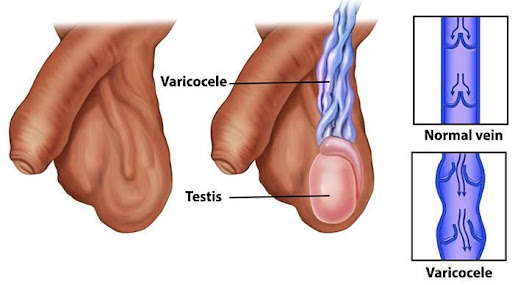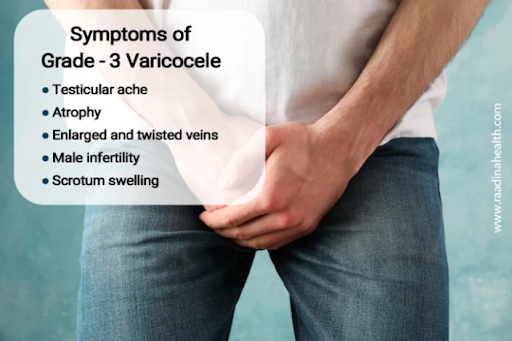Varicocele
 Veins throughout the body carry blood from various organs back to the heart. Normally, they have valves that ensure the blood moves in the proper direction. However, when valves in the testicular vein are incompetent, gravity can make blood collect in the scrotum surrounding the testicle, causing a varicocele. It is often described my clinicians and patients alike as being like ‘A bag of worms’. They can be present on either side but are more common on the left due to natural differences in drainage routes. They are graded according to their size:
Veins throughout the body carry blood from various organs back to the heart. Normally, they have valves that ensure the blood moves in the proper direction. However, when valves in the testicular vein are incompetent, gravity can make blood collect in the scrotum surrounding the testicle, causing a varicocele. It is often described my clinicians and patients alike as being like ‘A bag of worms’. They can be present on either side but are more common on the left due to natural differences in drainage routes. They are graded according to their size:
-
Sub-clinical — detected only by Doppler ultrasound.
-
Grade I (small) — palpable only with Valsalva manoeuvre.
-
Grade II (moderate) — palpable without Valsalva manoeuvre.
-
Grade III (large) — visible through the scrotal skin.
Varicoceles can cause three main problems: Impaired fertility, decreased testosterone production by the testis, or scrotal discomfort. Varicoceles are a relatively common cause of low sperm production and decreased sperm quality (particularly OAT’s). They are seen in roughly a third of normal adult males but can be seen in up to two-thirds of men suffering with MFI.
 They can be completely asymptomatic until trying to conceive or can cause pain (often a dragging sensation worse towards the end of the day) and even testicular shrinkage or atrophy. They tend to come on gradually, if they appear rapidly (especially if aged over 40) urgent referral should be made to rule out conditions such as kidney cancer.
They can be completely asymptomatic until trying to conceive or can cause pain (often a dragging sensation worse towards the end of the day) and even testicular shrinkage or atrophy. They tend to come on gradually, if they appear rapidly (especially if aged over 40) urgent referral should be made to rule out conditions such as kidney cancer.
It’s important to have an individualized approach to varicocele management. The decision to treat a varicocele is made based on the size of the varicocele, the patient’s fertility goals, symptoms of low testosterone levels or scrotal discomfort, blood tests such as testosterone levels, and/or semen analysis findings. Most varicoceles don’t require any intervention. But if associated with pain or reduced sperm count surgical intervention may be required.
.jpg) Mr Gordon using an operating microscope and micro-doppler in a complex varicocele case.
Mr Gordon using an operating microscope and micro-doppler in a complex varicocele case.